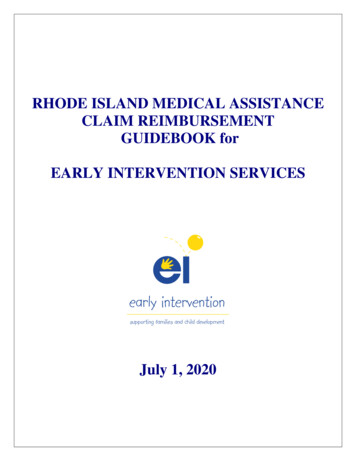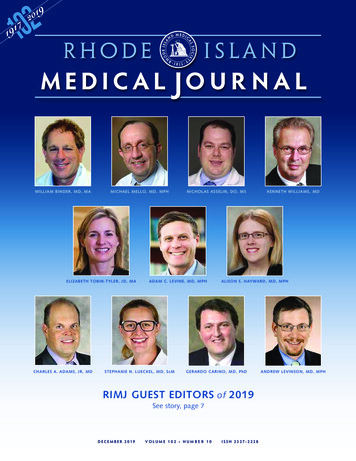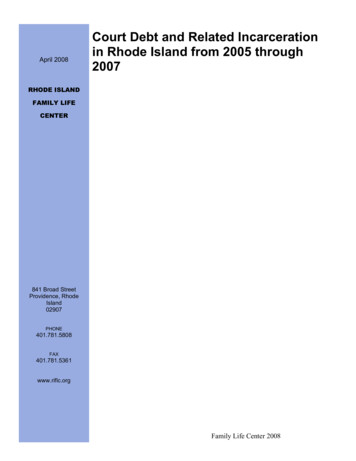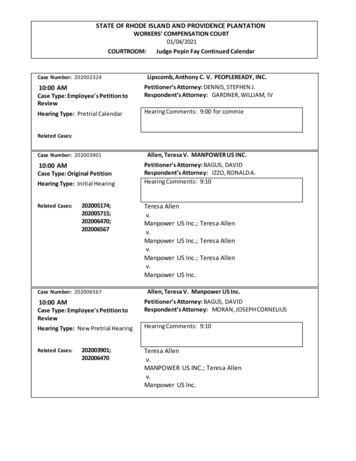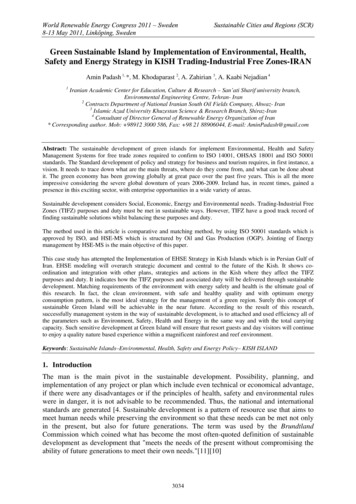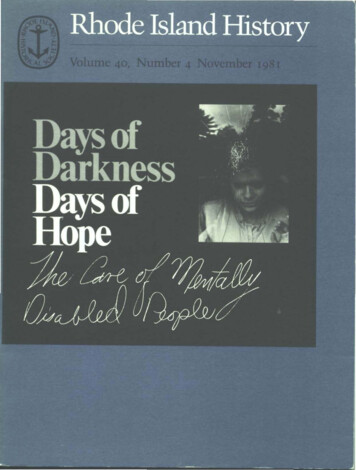
Transcription
Rhode Island HistoryPublished by The Rhode Isl.a.nd HtsroncalSociety, 1 Po.er SUCTt, Providence,Rhode leland, 01906, and pnnted by aii:lant from the Sta le 01 Rhode Island andProv idence Plantations, I, loseph Ga rrahy,Governor,Issued Qwnerly al Providence, RhodeIsland. february, May, Au,;ust, andNovember Second class posta e p.ald atProvidence, Rhode IslandE.d nonal otfiCC8 at Aldnch House,110 Benevolent SUeT1, Providence,Rhode Isl.a.nd, 019()tlRichard F. Stapln, preudemAlden M. Andenon. VIa' pre.SJd nrFunk Licht , VICt'preudt'nrRichard A Sherman, secretaryM , Rachel Cunha. asssstant secretaryKarl F. En cson , treasurerStephen C. William s, aSSlSfanr fua SUlt'1Alben T. K1ybel dne ctorVolume 40, Number 4November 1981"Days of Darkness, Days of Hope"A Special IssueContentsIntroduction107JO HN T . D U FFYForeword109S EY MOUR B . S A R A SONFEllOWS OF THE socrerrCarl Bndt'nbau jthSydney V lamesAmomeue F. Do.ru ngPUBLICAT IONS COMM ITTllDr, See bert J. Goldows ky, chairmanGo rdon Alle nHenry L P, Beck with. lr .Dr. f rancis H. Cha teeProl. Howard P, C hudacoffDr. Pat rrck T Co nleyWendell D. Garre t!Pamela A. KennedyE. Andrew Mo. brayCharles P. O' Don nellAlan Sim pso nSTAffGlenn Warren Lifantasle, edIto rMaureen Taylor. picture edJlorlean LcG win, designerDeborah S. Doolmle , ednonoi asuslantThree Cent uries of Care of the MentallyDisabled in Rhode Island and the Nation,t 650-1 950DAVID A . R O CH EF O R TMental Retardation, State Policy, and theLadd School, t 908-t 970 The Parents Coun cil for Retarded Childrenand Social Change in Rhode Island, t 951 - 1 970BARBARA B AIRRhode Island HlslOry 11941 - 1and ItSpredecessors, Rhod Is/and HruoncalSoclt'ly CoJJ cuons ( 19 18 - 19 4 11 an dPub/ICDllons of Ih Rhod IslandHistoncal Soclt'ry (189 )- 190 11, areaVlIll.a.ble 111 mi crofilm lrom UmversuvM icrofil m s. JOO Nonh Zeeb ROlId, AnnArbo r, Ml chl n . 4 81 06. Please wme lo rcomplete utlorrruuon Anlclcs appc.anngIII Ibis journal arc aMu.ac u d .and InduedHi5fo"c J1 AbHIOCUHuwry and LJfe,md133ERI C C . S C H N E ID E RThe Rhode Island H rstonc al Socreryass umes no respo nSibility lor theopuuons of corunbu roes.lDII 1AmCllCDa HOD ISlAN D H I STo n(ISSN OOH "ol6191145l
IntroductionThe idea for [h i!' publicauon was born eight years ago whe n I met parents of mentally retarded children at t he loh n E. Fogart y Center in Providence . They had incredible tales to tell. T h ese parents to ld of thestruggles of keeping their children at home, the batt les in creatingneeded services, the IO).'S ot scemg their dreams materialize, and thefrustration of seeing their reform movemcnt wane. The idea for thispubhcanon was a1 ,0 nurtured when, eight years ago, I met personslabeled mentally re tarded who had spent most of then hves at LaddSchool In Exet er, Rhode Island . T h ese persons to ld of being forced toleave thei r homes against t heir wi lls , of being incarce rated in ove rcrowded wards. o f scrubbi ng floo rs late In th e evening, of plots to es cape, o f leanu ng abou t St.'X by spymg on amorous attendant s In t hen igh t, oi episodes of courage in he lp ing each other ove rcome a te rr iblefate.Encouragement for an ex hrb inon and a publi cati on about the experie nces of t he mentally reta rded and their famili es came from Dr .Fredenc w eber, t he resourceful and se ns itive associat e director of th eRhod e Island Co m m ittee for th e Humanities. He suggested t he invol ve ment of D r. Joseph Bevilacqua, director of the Rhode Island De partment of Mental Health , Retardation and Hospital s, wh o had alread y expressed an Inte res t in developing a similar projec t in th e fieldof m ental h ealth. Dr. Bevilacq ua and photographer Sal vatore Manciniboth agreed that th eir desi re to put tog ether a photographic ess ay contrasting institut ional and co m m u nity programs for th e m entall y illcould he in corporated into a proje ct about retarded peopl e and thei rfamilie s. O ut of these plan s, "Days of Darkness, Day s of Hope," a malor publi c ed ucation proic ct . came into being.In th e proce ss of developing this pro ject, including a search for th eauthors of these arti cles, I had th e splend id opp ortunity to receive exce lle nt advice from out standing sc ho lars in the field s of m enta l healthand m ental retardat ion . Dr. Seym ou r Sarason of Yale Uru vcr suy was avery early sou rce of stren gth an d great inspi ration. Dean Burton Blatt ofSyrac use Univer sit y rai sed important question s and s uggested that hi storian Da vid Rothm an become Involved . Drs. Gu n nar and Rosemar yDybwad of Brandeis Univer sit y offered co u ntless s uggestions and m adenumerou s books and art icles available to our resear ch ers . Locally, Dr .Paul Sherl ock of Rhod e Islan d Co llege an d Dr. Robert Carl of th e Rhod eIsland Department of Mental Health, Retardat ion and Hosp ital s wer eon hand for frequent co ns u lt at ions from th e earliest stages of thispro ject .Mr. Albert T. Klvberg of the Rhode Island Historical Soci ety sug-
08I N T R O D U C TI O Ngested that Dr. Howard Chudacof become involved in helping to idcnufy potential researchers from Brown University. Dr. Chudacoff did soand offered man y other services. Dr. David Rothman of Co lumbia Urnversirv offered ma ny sugges t ions, and expressed his Interest in helpingwith th e ennrc proiect . Dr . Gera ld Grob of Rut gers University gave mean invalua ble introducti on to th e di scipline of histor y and suggestedthe path whi ch event ually led to two of the researchers for thi s prcic ct .Finally, Dr. Barbara Rosenkrantz provided cont acts with her colle aguesat Harvard Universit y th at dir ectl y resulted in an expansion of th eareas of research.Th e plight a. people with ment al illness has long been chronicled byRothman, Grob. Deutsch, Rosenkrantz, and, in Rhode Island, by JacobsField, and Jones , We hope that this issue of Rhode Island History landano ther specia l Issue, devoted to SImilar themes, which will appear in19821 will provide additional mfo rmanon th at will resu lt in a bcnerunderst andin g of persons with ment al illness .The plight of m entally retarded people, however, ha s seldom (iI eve r)been recorded by histori ans, One very dist ingui shed social historianhas said that the experiences of th e mentally retarded are of little his torical value . I trust that thi s publi cation will alert scholars to a won derful source of historical study int o th e unconquerable strength of th ehuman spint.Rhode Island His tory is to be congratu lated for making such an overwhelming commitme nt to revealing this hidden history. It is fitt ingthat th e art icles for these two special issues were com pleted during th efinal months of 198J - "The Int ernational Year of Disabled Persons."IO Hl'O T . DUff YCran ston, Rhode Island"Days of Da rkness, Days of Hope " is a major public education project sponsored by the Rhode Island Department of Mental Health, Retardation and Hospitals. Besides thi s special issue of Rhode Island History land a second issue that will be published in late 19 821, th e protectincludes an exhibition with nin et y photograph s and text com me nta ry,lectures, and a series of publi c service announcem en ts. Th e project hasbeen made possib le in part by a grant from th e Rhode Island Co m mittee for th e Humanit ies. Addinonal support has been provided by:Rhode Island Development Disabilities Counci lThe John E. Fogarty Ce nter-G reate r Providence Association for Retarded CitizensBlackstone Valley Association for Retarded Citi zensCranston Association for Retarded CitizensNorthern Rhode Island Association for Retarded Citizenswesterl v-Chanho Associ ation for Retarded C itizensCi tizens Co m munity Foundation
ForewordOve r one hundred years ago, Doro thea DIX spoke before the Massachu setts legislature. She had Visited many of what In those days we recalled "h um ane mstuunons" which were for people who were "drt ferent " and needed some kind of hel p and service from others. She de scribed the ho rrors she had seen and she did this so well , so convmc ingly, that a movement was sta rted to make th ese institutions tr u lyhumane. Over a hundred years later, and agam to the Massach uset tslegislature, Dr. Bunon Blatt gave m uch the same ta lk . But he had theadvantage that he cou ld show pict ures. It is one thing to woe words todescribe inhumanity. It IS another th in g to M"C th e inhum.anny : to cap'tur e it In a way that the human eye canno t igno re and the no rmal mindmust ponde r. What happen ed in the century or so between the twotal ks! Unfortunat ely the answer is clea r: every decade or so, the snua nons that had im proved had fall en victi m again [0 the old ev ils . Tenyears afte r D r. Blatt first vis ited th e ins ti tutions he lit erally pictured InChristmas in Purgatory, he rev isited th em an d again took pict ur es.The institution s were clea ne r, th ere was more equi pme nt , and therewas less crowding. But o ne cannot escape th e conclusion th at these institutions contain exiles from th e normal soc iety wh o live lonely, un stim ulated lives unbnghtened by love, laughter, frien dsh ip, and sustained human warmth.There are some peopl e wh o beli eve that these institution s arc inca pabl e of being humane except for very short period s of time . There aremany more peop le who believe that very few indi vidua ls need to live inthese institutions but rather can live and even work in our natura lcommunities, with or near their families. But in orde r to do so, th eyhav e to be seen as citize ns wh o have rights no less than we ha ve. Thefact that they may be "different" can never be a basis for depriving indi viduals of th eir rights to live as normally as possible in their comm unities.Man is an imperfe ct being. Man or woman, young or o ld, educ ate d ornot, rich or poor, wise or stu pid-each needs to be reminded th at whatgives the most meaning to our lives, wha t stands up best over thecourse of our lives, is th e feeling that we are not alone but that we arepan of a dependable network of soc ial relationships. How ever differentpeopl e may appear, let us not forget that behind those appearances arecommon needs. Being imperfect , we do forget. This publi cat ion w illhelp you remember.SEYMOU R B. SA RASONProfessor of Psych ologyYale University
The State Almshouse. Howard.Rhode Island. Photograph bySalvato re Mancini .
Three Centuries of Care of the MentallyDisabled in Rhode Island andthe Nation, I650-I950by David A. Rochefort*IRecu rri ng patterns have m arked th e hi sto ry of th e care and tr eat m entof the me nta lly ill and retarded. At one end of th e pendulum's swing,soc iety has stigmat ize d the m entall y di sa bled as an evil m en ace; at th eothe r, it h as co nsidered them helpless victims deser ving of co ncernan d kind ness . Etiological th eori es hav e also varied greatly, as men taldisabiliti es by turn s have been lin ked to phy sical disease, communitydisorder, and even personal im mo rality. Ideas about how to deliver careto th e me nta lly disa bled have also vacillated over tim e; th e focus forsuch care has shifted more th an once from in st itution s to comm unity'based services and the n back again. Cont rary to th e widespread not ionthat society advances progressively, th is record is one of fits and starts ,of gain s won in one era only to he lost in th e next .Social and economic forces as much as medical influences haveshaped thi s hi story. For example, social stratification pattern s in America have det erm ined the growth of a two -class syste m of mental healthcare for th e rich and th e poor, and for Anglo-Saxon and other ethnicgroup s.I Simila rly, signi ficant changes in treatment practi ces oftenhave stem me d from broad religious and social reform movements thatos tensibly have had littl e to do with physical or mental health care .Above all, th e cyclic al developm ent of mental health care can be directly related to changing att itudes toward th e mentally ill and retarded and to wid espread beliefs concern ing the und erlying nature ofth eir disability. Dr. Oliv er Wendell Holmes, writing in 1861, com mented on th e influ ence that prevalent ideas and material conditionshave on medical care: "The truth is, that medicine, professedlyfounded on observation, is as sensitive to outside influences, political,religious, philosophi cal, imaginative, as is the barom eter to changes ofatmospheric den sit y. Theoretically it ought to go on its own straight forward indu ctive path , without regard to changes of government orfluctuations of public opinion. [Actually there is] a closer relation between Medical sciences and the conditions of Society and the generalthought of the time, than wou ld at first be suspected."? And so it hasproved for th e care and treatment of the mentally disabled .* Mr. Rochefort is a doctoral candid ate inthe Ame rican CIvilizat ion program atBrown Unive rsity. He is also emplo yed asa health Iacihtres specialist III t he Officeof Health Syste m Planning, Rhode IslandDepa rtment of Healt h He wishes tothank Bruce Kelley, Robert Carl. GerardLobosco, lam es T. Patte rson, an d PhilBrown for th en comme nts and suggest ions on an earlier draft of this essay. Healso thanks Eileen M. Tracy for he r helpm resear chi ng rhi s essay and preparingthe man usc ript for pubhcanon.I. Th rou ghout thi s essay, "ment alhealt h care" IS used m a gene ral sense rorefer to tre atment of both the mentally illand reta rded. In selec u eg specific language to refer to the menta lly ill and retarde d, I have generally adopted thoseterms in use dunng th e period und er drscuss ton regardless of whe ther th ey arecons idered appruprtat e or sugmauzmgtoda y,1 . Q uoted in Norman Dam, Conceptsof lnsamty In the u mied Stales .n89 -r865 1New Brunswi ck, N.)., 1964),xv. 1981by David A. Roch efort
11 THREE- C E N TU R JE.S Of C A R E.1 Alben Deuoch, The Men tally Il/ InA m u lca, ad. ed. iNc: w York, 1949\. 6. Q UOted Ul l b Jd ., 11 - 1 J.s. IbId ., I IIIbId ., 14 - 1 .7. IbId. J9-S 4.II . ul dN Grob, Men-Idiln sutulJ on s In A m t m :a SOCUJJ Policy10 / &7' (Ne w York . 197'J1. 1- l48. Deutsch , Mentall y IlJ InAm tllC J,J Jl . See a ho Sey mour B !),araw n an dlohn Dorta. PsychologIcal Ptoblc:m InM ent al Dc:f] ClffiCY, 4th ed. (New York,19 6 9 1, 111 - 1 14IIThroughout most of West ern hi story, menta l disabi lities have beenviewed in terms of the supern atural. This tendency peaked duri ng th eMiddle Ages, wh en "lun acy" and " idioc y" were under stood eit he r asdivin e pun ish m ent or t he resu lt of in vol vem ent with ev il spirits . As Albert Deutsch, author of The Ment all y III in Am erica, remarks, "T herapeutic measures in mental illn ess [have been ] based on the prevailingth eory of causes ,''' Accordingly, In medieval ti mes the primary me th ods of prevention and care were magic and rit ual. For example, a tenthcent ury cure for insanity, recommended by the Reverend OswaldCoc kayne in a volume entitled Leechdom s. \Vor tcunmng and Star crafrof Earl y England, was typical of its day: "In case a man be lunatic; takea skin of mere-swine [sea-pig] or porpois e, work it int o a whip, swingethe m an th erewith , soon he will be well. Amen .?' At its worst, the me dieval approac h to th e problem of me ntal devia ncy was less antic; ithas been estimated th at, between the mid -1400S and 1700, not lessthan 100,000 persons were execu ted as witches, many of whom probably suffered from some form of mental illness.'Bringing with them European customs and atti tudes, colonia l Americans shared man y Old World superstitio ns abou t mental disabilities.In th e mid -r soos, th e wh ippin g post and th e gallows were commo npuni shment s in cases of supposed dem oni c possess ion." But at th esam e tim e, a more benign ap proach was slowly coming int o existenceas West ern societ y emerged from th e shadow of th e Middle Ages. Bythe late 1700S, for example, physicians were beginning to cons ider therelationship between insanity and a number of natural causes such asdisease, excess sexual activity, and stress. And even if man y citizensstill related illn ess and handicaps to th e will of God, more and moreth ey also recognized mental disability as an economic and social problem requiring instrumental action.In practice, th e mentally disabled in America fell under th e systemof poor laws and received an informal, case-by-case respon se.' Th e violent in sane were tr eated lik e crim ina ls and thrown into iail . Other afflicted persons, if depend ent on publi c resour ces, were occasionallyhoused in privat e dwell ings at th e town 's expense. Sometimes townseven offered finan cial support directl y to th e family of a mentally disabled person so that he might rema in in his own home. Later, duringthe second half of th e 1700S, authorities often placed the insane andfeebleminded in workhouses, hou ses of co rrection, and almshouseswhich were qui ckly spreading across th e states. It is impo rt ant to emphasize that dur ing th e colonial period (and even later] most Ameri cans did not distinguish between th e insane and th e feebleminded.Both fell int o the category of "ment al defectiveness," and, in the wordsof one author, tr eatment practic es for th e two groups were "inextricably bound" together." like th e insan e, a feebleminded person wh oprovoked fear or suspici on was likely to be imprisoned or negle cted.
1THREE CENTU RIE S OF CARf.Practices in Rhode Island ill us trate these gene ral trends , The first recorded consideration of pub lic provision for th e mentally disabled inthe colony dates back to 16,1 and invo lved Roger Willia ms, In a letterto the Providence town counci l written on January 12 , 165 I , Williamsrequested that the town assume control of the prope rty of a Mrs . Westonand take care of this unfortunate citizen who had become a "d istracted"woman :I crave your consideration of that lamentable objec t Mrs . Weston,my experien ce of the distempers of persons elsewhere makes meconfident that [al though not in all things yet ] in grea t measure sheis a distracted woman . My request is that you would be pleas ed totake what IS left of hers into your own hand, and appoint some toorder It for her supply, and it may be let pubhke act of mercy to hernecessines stand upon record amongst the me rciful acres of amerciful town that hath received many me rcies from Heaven, andremembers that we know not how soon ou r own wives may bewidows and our child ren orphans, yea, and ourse lves be deprivedof all or most of our reason, before we goc from he nce , exceptmercy from the C od of mercies preve nt it."Within two mo nths the town cou nc il placed Mrs. Weston (her name atthis time actua lly was Goodwin beca use of remarr iage! forma lly int othe care of six me n who were given the power to sell he r propert y ino rder to mee t any debts associ at ed with their respon sib ilit y. In Evidentlythe woman did no t receive th e best of care under thi s arran gem ent, fora month lat er she died afte r wande ring about alon e and naked during am idn ight storm .Suc h personalized care, wh ether it proved ben eficial or not , was impossibl e to cont in ue as Rhode Island's towns grew in size and popul ati on . By the early 1700S, Rhode Island joined in the larger movement toestablish almsh ou ses that would house the poor and th e mentally disabled. The town of Newport established th e colony's first almshouse in1713, and sev eral other towns soo n followed with th eir own .v ln 1741,the co lony passed a law giving to wn counc ils th e pow er to ass ume fullresponsibility for th e care of insane and feebleminded person s in th eircom m unities and to nam e guar dian s of their estates ." The effects ofthis law were far-reac hing, for it helped to inau gurat e a sta ndard approa ch to the care of th e mentall
legislature, Dr. Bunon Blatt gave much the same talk. But he had the advantage that he could show pictures. It is one thing to woe words to describe inhumanity. It IS another thing to M"C the inhum.anny: to cap' ture it In a way that the human eye cannot ignore and the normal mind must ponde


